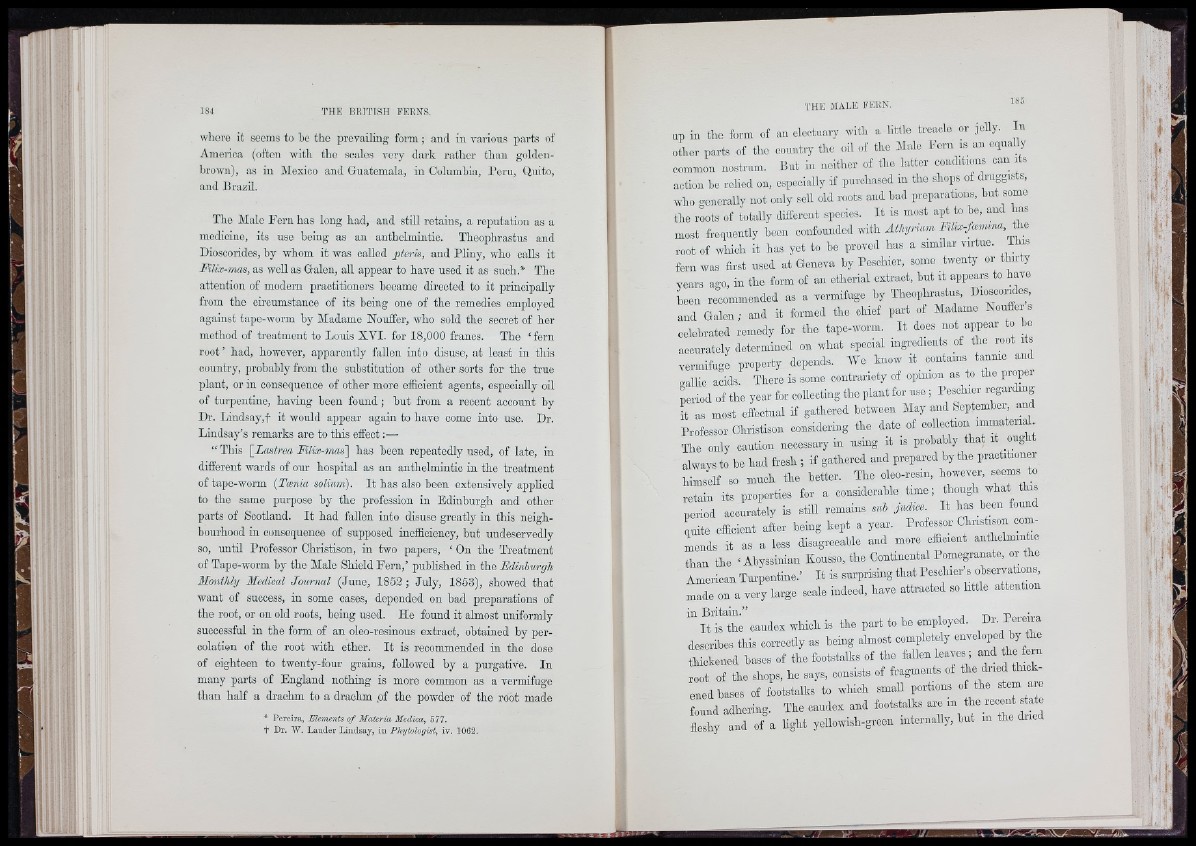
wliore it seoms to bo tho prevailing form; and in various parts of
America (often with tho scales very dark rather than golden-
brown), as ill Mexico and Guatemala, in Columbia, I ’eru, Quito,
and Brazil.
The Male Fern has long had, and still retains, a reputation as a
medicine, its use hoing as an anthclniintio. Theophrastus and
Diosoorides, hy whom it was called pteris, and Pliny, who calls it
Filix-mas, as well as Galen, all appear to have used it as such.* The
attention of modern practitioners became directed to it principally
from tho circumstance of its being one of the remedies employed
against tapo-worm by Madame Nouffer, who sold the secret of her
method of treatment to Louis XVI. for 18,000 francs. The ‘ forn
root’ had, however, apparently fallen into disuse, at least in this
country, probably from tho substitution of other sorts for tho true
plant, or in consequence of other more efficient agents, especially oil
of turpentine, having been found; hut from a recent account by
Dr. Lindsay,! it would appear again to have come into use. Dr.
Lindsay’s remarks are to this effect:—
“ This \_Lastrea Filix-mas\ has been repeatedly used, of late, in
different wards of our hospital as an anthelmintic in the treatment
of tapo-worm {Tienia solium). I t has also been extensively applied
to the same purpose by the profession in Edinburgh and other
parts of Scotland. I t had fallen into disuse greatly in this neighbourhood
in consequence of supposed inefficiency, hut undeservedly
so, until Professor Ohristison, in two papers, ‘ On the Treatment
of Tape-worm hy the Male Shield Fern,’ published in the Edinburgh
Monthly Medical Journal (June, 1852 ; July, 1853), showed that
want of success, in some oases, depended on bad preparations of
the root, or on old roots, being used. He found it almost uniformly
successful in the form of an oleo-resinous extract, obtained by percolation
of the root with ether. I t is recommended in the dose
of eighteen to twenty-four grains, followed by a purgative. In
many parts of England nothing is more common as a vermifuge
than half a di-aohm to a drachm ,of the powder of tho root made
* Pereira, EUments o f Materia Medica, 577.
t Dr. W. Lauder Liiidsay, in Phytologist, iv. 1062.
lip in the form of an electuary with a littlo treacle or jolly. In
other parts of the country the oil of the Male Ecm is an equal y
common nostrum. But iu neither of tho latter conditions can its
action ho relied on, ospooially if purchased in tho shops of druggis s,
who generally not only sell old roots and bad preparations, but some
tho roots of totally different species. I t is most apt to be, and has
most frequently boon confounded with Hi/iyri«» the
root of which it has yet to ho proved has a similar virtue. This
fem was first used at Geneva hy Pesohier, some twenty or thirty
years ago, in the form of an etherial extract, hut it appears to have
been recommended as a vermifuge hy Theophrastus, Dioscorides,
and Galon; and it formed the chief part of Madame Nouffor s
celebrated remedy for the tape-worm. I t does not appear to ho
accurately determined on what special ingredients of the root it
vcrniifugo property depends. Wo know it contains tannic and
gallic acids. There is some contrariety of opinion as to the propc
period of tho year for collecting the plant for u se ; Pcschior regarding
it as most effectual if gathered botwoon May and Soptembeiq and
Professor Ohristison considering the date of colloction immaterial
The only caution necessary in using it is probably th a t it oug
always to he had fresh ; if gathered and prepared hy the practitioner
himself so much the better. Tho oleo-resin, however, seems to
retain its properties for a oonsiderahle time; though what thi
period acouratoly is still remains sub gudiee. I t has been foun
[u ite efficient after being kept a year. Professor Ohristison commends
it as a less disagreeable and more efficient anthelmintic
than the ‘Abyssinian Kousso, the Oontinontal Pomegranate, or the
American Turpentine.’ I t is surprising that Peschior’s observations,
made on a very large scale indeed, have attracted so little attention
I t is the caudox which is the part to he employed. Di. Pereiia
describes this correctly as being almost completely enveloped by the
thickened bases of the footstalks of the fallen leaves ; and the fern
root of the shops, he says, consists of fragments of the dnod -
enod bases of footstalks to which smaU portions of the stem are
found adhering. The caudox and footstaffis are m the recent state
fleshy and of a light yellowish-green internally, hut in the drie
*